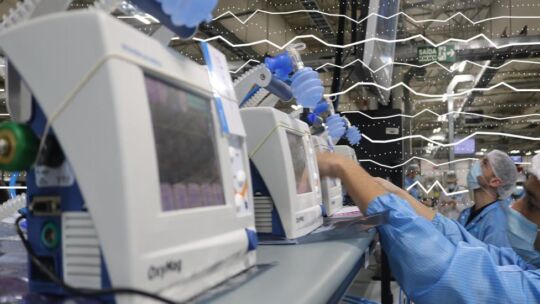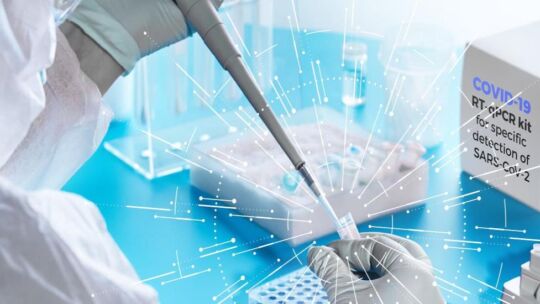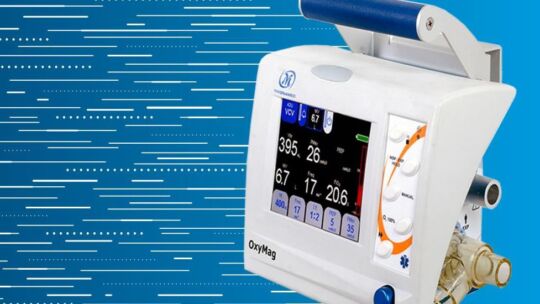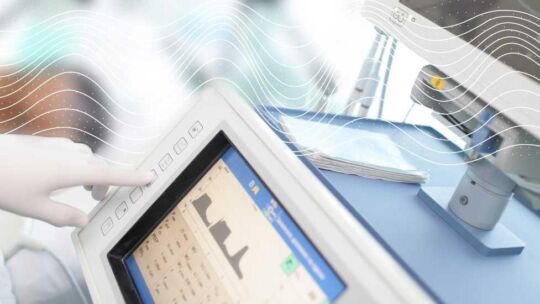
The challenge
As COVID-19 raged around the world in 2020, Intensive Care Units (ICUs) began to fill up with patients severely ill from the virus.
Intensive care is the last line of defense, where the most critically ill patients are treated. Some are given oxygen to help them breathe, while others are put on ventilators to do the breathing for them. All will be given medication to ease symptoms.

The medication is usually delivered via an infusion pump — a piece of medical equipment that delivers fluids into a patient’s body in controlled amounts. These mechanical and programmable pumps can deliver larger quantities of medication than other methods like a syringe or a simple IV, which uses gravity to control the flow.
Infusion pumps offer the flexibility to automatically and precisely administer specific amounts of medication at set times. Because each pump delivers a single medication, some patients require multiple pumps to be used at the same time.
As COVID-19 patients began to fill hospital ICUs, supplies of infusion pumps quickly depleted. A surge of orders went out to suppliers and pressure mounted to manufacture more. Our site in Timisoara, Romania had been making infusion pumps for many years; the team there was capable of shifting production gears by as much as 20–30 percent to respond to the customer’s demand spike.
This time, however, the team had to make five times as many pumps to meet demand. And do it quickly as COVID showed no sign of relenting. Hospitals and patients were waiting.
Manufacturing lines are not capable of producing five times what they normally do. Scaling up presented another hurdle as the pandemic had caused supply lines to be either locked down, broken down, or closed down. Even one missing part could mean the infusion pumps could not be manufactured.
The solution
The first step in ramping up production was to increase the number of shifts on existing production lines to produce and ship higher volumes immediately. In parallel, space in the factory was cleared and work got underway to build the additional production lines.
New production staff were recruited, and some existing employees were redeployed from other areas of the factory. Both groups were immersed in an intensive training program to get them up to speed quickly. Pressure or no pressure, the quality of the product had to remain at the highest levels.

No medical company would tolerate a compromise on quality. Quality is a given. It’s something we don’t even discuss. Whatever we deliver in the future has to be the same quality as before.
— Fabio Rotelli, Account Manager and Senior Director at Flex
However, the real challenge came with supply of the components that made up the infusion pumps. The pressure caused by the dramatic increase in demand was felt throughout the supply chain. Both our suppliers and customer-directed suppliers needed to increase their production of parts quickly.
When the chips are down, scale matters. One of the advantages of being a large, global manufacturer is that some common components could be sourced from different suppliers or even different parts of the company. While there was a huge increase in demand for medical supplies and devices, other areas of the economy slowed down, freeing up components that could be channeled into the production stream for infusion pumps.
Going the extra miles
I don’t know how many extra miles we ran. The news was all about how intensive care units were being filled up. But in some cases, even if you had an intensive care bed, you might not have the equipment to care for the patient.
— Fabio Rotelli
There were daily supply chain meetings with the customer, where we were united in pushing for every extra unit we could make.
The infusion pumps use customized components, such as internal motors, which are built exclusively for them. In many cases, just one supplier provides a specialized component, and for a smaller manufacturer, having a demand or shortage challenge on this scale could be catastrophic. Each supplier was given access to our global supply chains, as well as those of our customer. Whatever they needed, it was sourced.
To motivate all suppliers in the network, we partnered with the customer to jointly deliver training about the product they provided components for. Many suppliers were unaware that the screws, motors, or other components they manufactured were vital ingredients in the battle against COVID-19.
The disruption and complexity in the supply chain grew as each government brought in their own unique restrictions and regulations. Trade routes were affected across the globe. Managing a global supply chain against this background of unique and shifting policies can be daunting, but experience and innovation helped us deliver for the customer.
Results
Everything that could be done to meet the increased demand for these life-saving devices was achieved — from increasing production shift patterns and accelerating supply lines to repurposing components from other areas.
In just 13 weeks, we had hired and trained production staff, built new production lines, and multiplied production five-fold. The new lines were fully operational while demand for infusion pumps remained high.
Our system worked because we had so many places to draw parts from. Fabio said one of the things the customer realized over the period is that we can rise above challenges and deliver.
Teamwork was critical to the success of this project. I think the two teams found each other to be very committed, and that was the cement that made this project work so well.
— Fabio Rotelli



